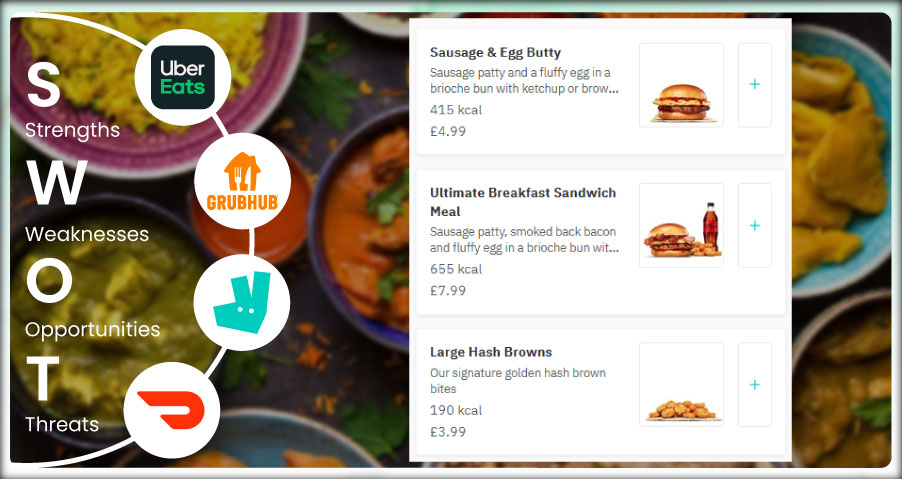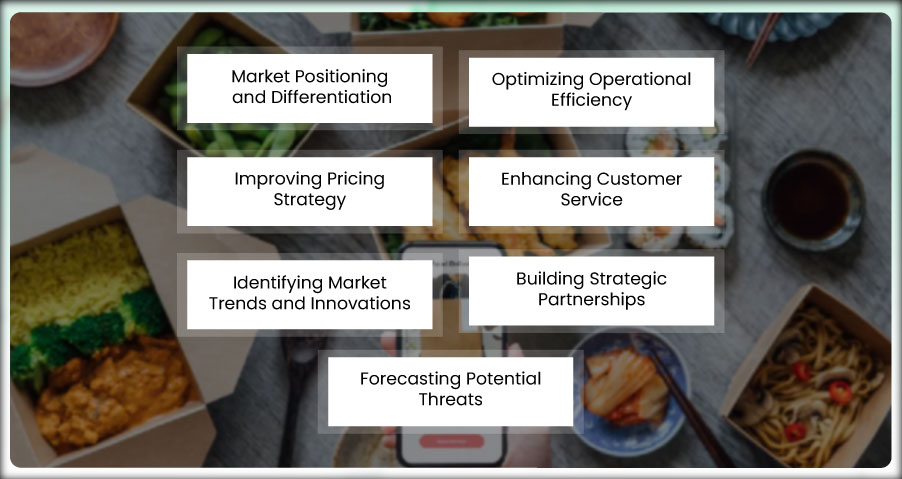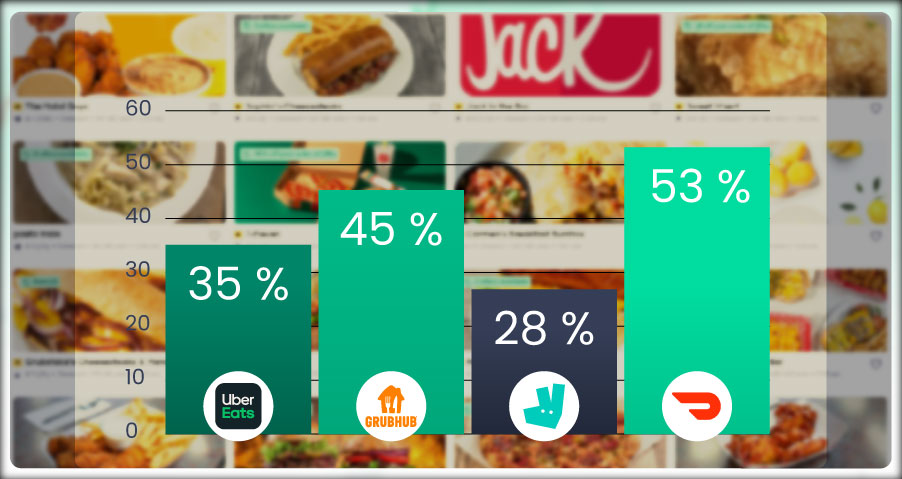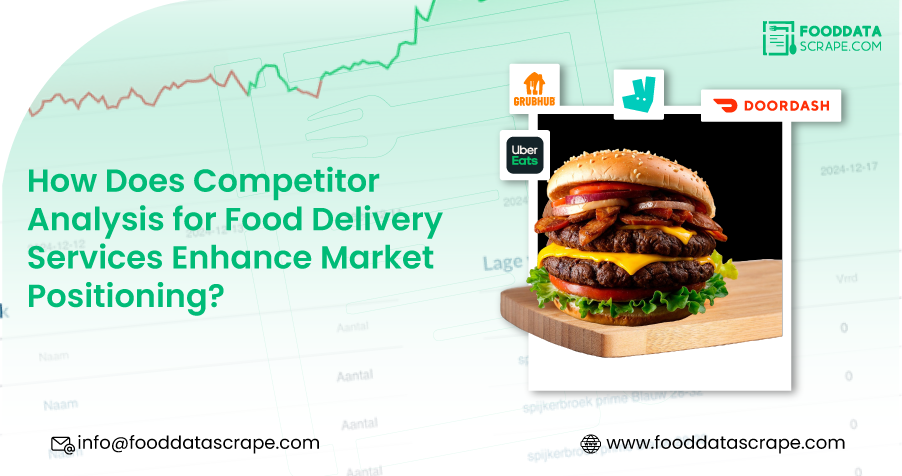Introduction
Food delivery services are vital to how customers access their meals quickly and effectively in the increasingly competitive digital space. These new platforms, Uber Eats, Grubhub, Deliveroo, and DoorDash, have increasingly seen heightened competition within the food delivery business. Companies in food delivery services must comprehend their competitive environment with Competitor Analysis for Food Delivery Services when developing a plan. Examining competitors' strategies can allow food delivery companies to understand the market trends, identify growth areas, and improve their business models. Analyzing Competitors to Boost Food Delivery Operations can make a company stand ahead through the use of data to improve its services and customer satisfaction.
In this article, we will discuss how competitor analysis can enhance strategy for food delivery companies, the benefits it provides, and how it guides decision-making and innovation in the industry.
Understanding Competitor Analysis in the Food Delivery Sector

Competitor analysis involves identifying and assessing significant players in the same market. In this scenario, such competitors would be companies offering food delivery services. By conducting competitor analysis, an organization can gain an idea of its place in the market through the SWOT analysis of competitors' strengths, weaknesses, opportunities, and threats. Scrutiny of services, pricing models, marketing strategies, customer base, and technological innovations presented by competitors constitutes this process. Food Delivery Market Analysis for Competitive Advantage helps companies gain insights that will enable them to strategize to outshine others in the market.
Competitor analysis is not just knowing what other companies are doing but also the gaps and opportunities a company can exploit. In the food delivery space, this would mean knowing how competitors use technology, how they approach customer service, their menu offerings, the speed of delivery, and the promotion strategies. By Improving Food Delivery Business with Competitor Analysis, a company can have its services optimized, improve its operational efficiencies, and hence find new means of fulfilling customer expectations.
Boost Your Business by Analyzing Food Delivery Competitor Data with Food Data Scrape.
Key Benefits of Competitor Analysis for Food Delivery Companies

Competitor analysis empowers food delivery companies to uncover market trends, identify opportunities, and refine strategies. By understanding rivals' strengths and weaknesses, businesses can enhance service quality, optimize pricing, and improve customer satisfaction to gain a competitive edge in the industry.
- Market Positioning and Differentiation: Competitor analysis helps food delivery companies identify their current market position and understand how they are perceived relative to their competitors. This understanding is critical when it comes to differentiating themselves from other services. For example, suppose a food delivery company observes that many competitors offer similar services at competitive prices. In that case, they may differentiate by providing superior customer service, offering unique food options, or adopting a specialized delivery process (e.g., contactless or eco-friendly deliveries). Optimizing Food Delivery Operations with Competitor Analysis enables food delivery companies to carve out a niche by tapping into underserved markets by delivering organic or diet-specific foods, targeting specific geographic locations, or offering exclusive partnerships with local restaurants. This approach helps position them as industry leaders or unique alternatives to mainstream services.
- Improving Pricing Strategy: Pricing is critical in any competitive market, and the food delivery industry is no exception. Through Competitor Data Scraping for Food Delivery Apps, food delivery companies can evaluate competitors' pricing models to identify areas where they might be overcharging or underpricing. For instance, a company may find that most competitors offer a flat delivery fee. Still, by conducting research, they might discover a preference for more dynamic pricing models, such as tiered fees based on distance or delivery time. This analysis guides companies to adjust their pricing strategies, balancing customer satisfaction and profitability effectively.
- Identifying Market Trends and Innovations: The food delivery industry constantly evolves, shaped by technological advancements and changing consumer behaviors. By leveraging techniques to Extract Competitor Data for Food Delivery Apps, companies can monitor emerging trends such as AI for route optimization, drones for faster delivery, or the rise of plant-based menu options. Additionally, companies can implement technologies like predictive analytics for demand forecasting or mobile app innovations to enhance user experiences. By staying updated on competitor strategies, businesses can adapt quickly to market changes, driving innovation and maintaining a competitive edge.
- Optimizing Operational Efficiency: Competitor analysis is valuable for improving internal processes, including supply chain management and delivery logistics. Through Web Scraping Food Delivery Data , companies can identify best practices used by competitors, such as efficient driver management systems that minimize wait times and optimize delivery routes. Adopting these insights helps enhance operational efficiency, resulting in faster deliveries, reduced costs, and improved customer satisfaction. These operational improvements are essential for staying competitive in a fast-paced industry where efficiency directly impacts the bottom line.
- Enhancing Customer Service: Customer service is a crucial factor in the food delivery industry, and competitor analysis provides valuable insights into best practices. For instance, Restaurant Menu Data Scraping can help companies understand how competitors manage customer queries, complaints, and feedback. Similar strategies can enhance customer satisfaction if a competitor is known for fast response times or offers compensation for delivery issues. Additionally, analyzing competitors' marketing campaigns and customer engagement initiatives can reveal effective ways to build loyalty. Companies can tailor their promotions, discounts, or loyalty programs based on what resonates with the target audience, driving higher retention rates.
- Building Strategic Partnerships: Analyzing competitors' collaborations with restaurants and food vendors offers insights into potential partnerships that drive growth. By using Food Delivery Scraping API Services , companies can identify successful partnerships competitors have established, such as collaborations with high-end restaurants or popular local eateries. Companies can then seek similar alliances or explore untapped restaurant categories. Additionally, insights into regional partnerships or exclusive collaborations can inform strategies for market expansion. Whether partnering with grocery chains or chefs for exclusive meal kits, strategic alliances help distinguish a brand from its competitors.
- Forecasting Potential Threats: Competitor analysis enables food delivery companies to anticipate and prepare for threats, ensuring resilience in a dynamic industry. For instance, using Food Delivery Intelligence Services , companies can monitor new entrants to the market, shifts in customer preferences, or changes in the competitive landscape. Companies can proactively respond by investing in marketing, enhancing services, or refining offerings if a well-funded competitor enters the market. Furthermore, competitor analysis uncovers emerging trends such as sustainable delivery options or subscription-based models. Companies can innovate and mitigate disruptions that may otherwise impact their market share by understanding these shifts.
How Competitor Analysis Influences Decision-Making?

Effective decision-making in the food delivery sector is rooted in data-driven insights, and competitor analysis provides an essential foundation for this. The knowledge gained from competitor evaluation helps food delivery companies make informed choices, from pricing strategies to technological investments.
For example, a company considering expanding its service offerings might base its decision on the success of similar moves by competitors. A food delivery company might be motivated to do the same if competitors successfully launch subscription services. Conversely, a company may pursue a more cautious approach if competitors' expansions have failed or resulted in losses.
Additionally, competitor analysis clarifies which marketing tactics work best in a given market. Whether it's social media campaigns, influencer partnerships, or local promotions, companies can evaluate which strategies have been effective for their competitors and adapt them for success.
Conclusion
In the fast-paced and highly competitive food delivery industry, competitor analysis is not just a tool for benchmarking; it is an essential strategy for staying ahead in the market. Food delivery companies can refine their strategies and position themselves as market leaders by understanding competitors' pricing models, operational strategies, customer service techniques, and technological advancements. Restaurant Data Intelligence Services play a pivotal role in enabling companies to gather and analyze data effectively, ensuring they remain informed about market dynamics.
Competitor analysis allows companies to optimize their pricing, enhance operational efficiency, and offer unique services that appeal to consumers. Tools like a Food Price Dashboard can provide real-time insights into competitor pricing and trends, aiding companies in making informed adjustments to their strategies. Additionally, using Food Delivery Datasets provides valuable insights into market trends, emerging innovations, and potential threats, helping food delivery companies remain adaptable and resilient in an ever-changing landscape.
If you are seeking for a reliable data scraping services, Food Data Scrape is at your service. We hold prominence in Food Data Aggregator and Mobile Restaurant App Scraping with impeccable data analysis for strategic decision-making.
























































































